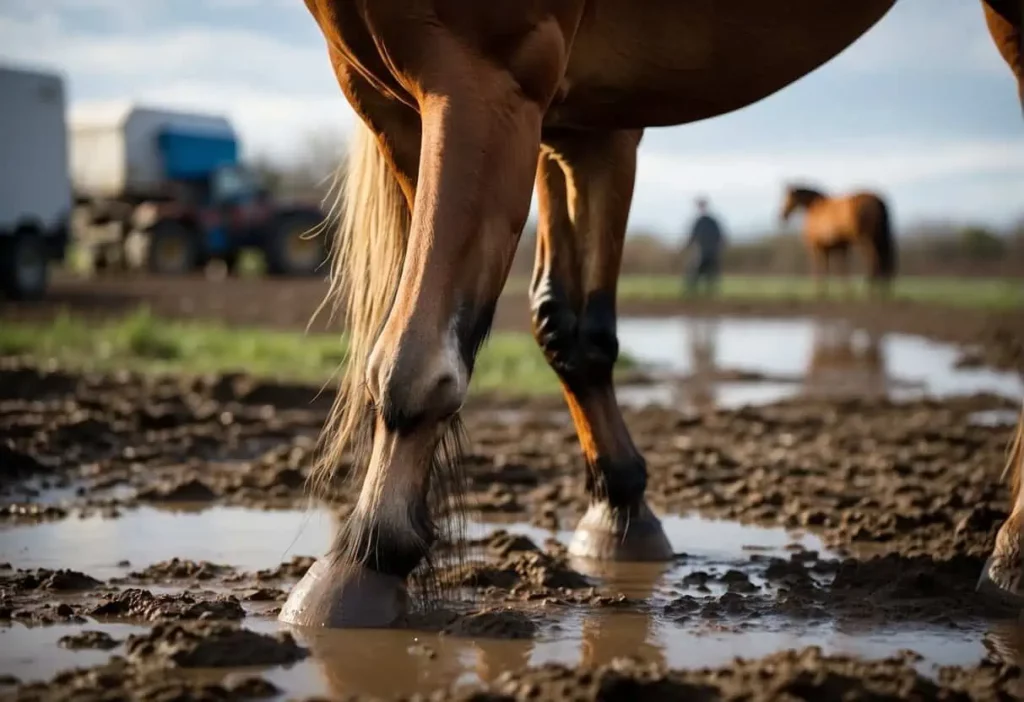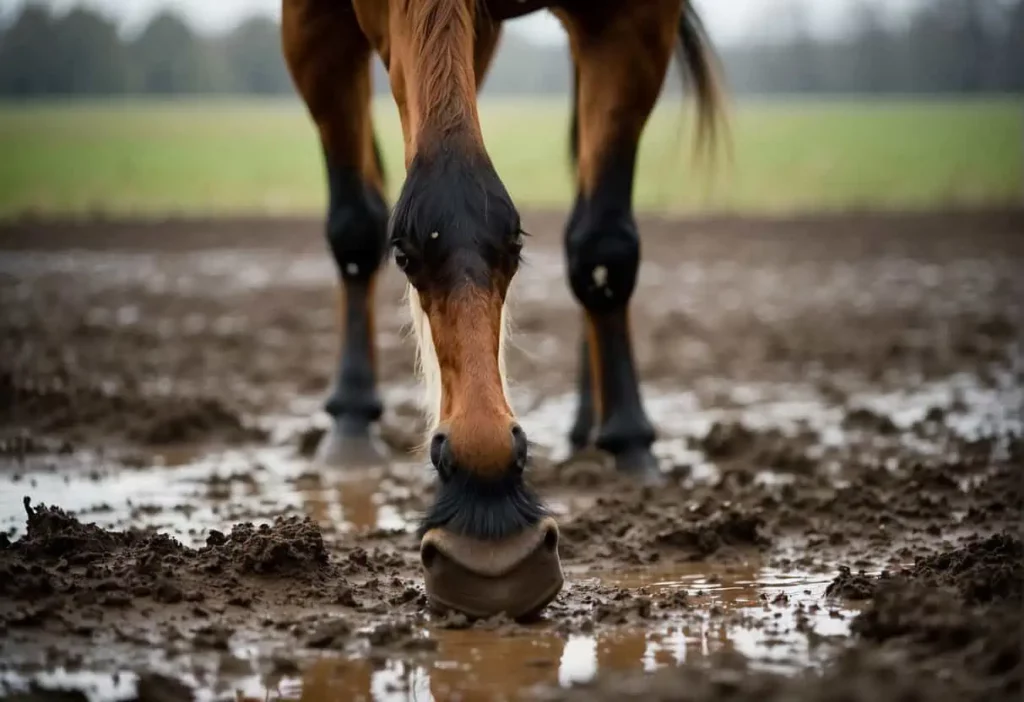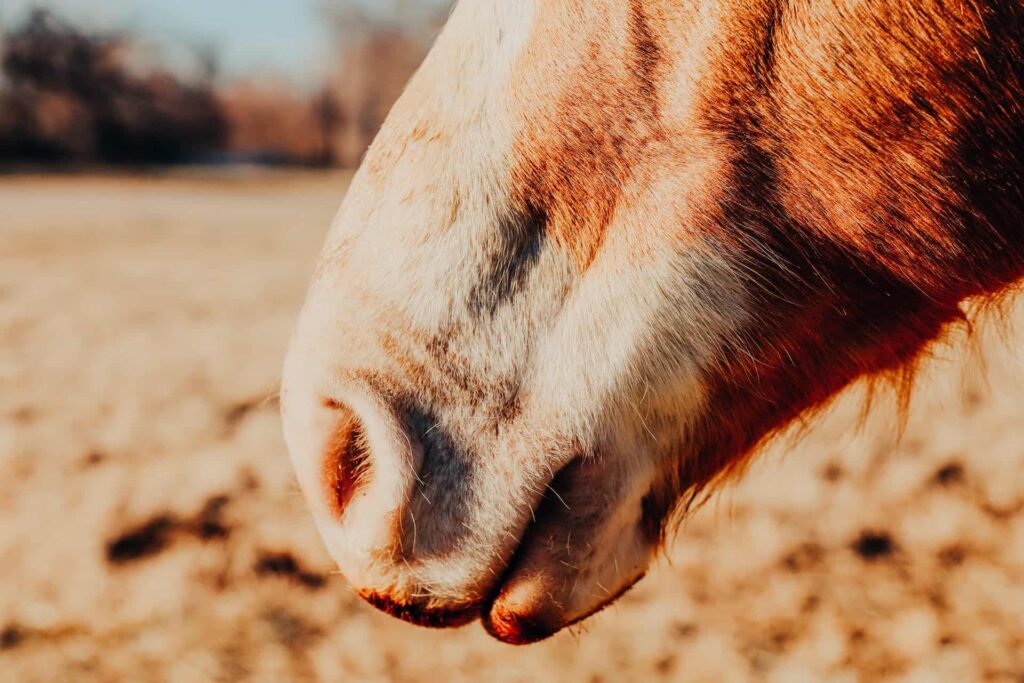Mud fever in horses is a common skin condition that typically affects the lower limbs, particularly in damp and muddy environments. Known scientifically as pastern dermatitis, it manifests as inflammation, soreness, and scabbing in the affected areas. The condition is usually seen in equines that have been exposed to wet conditions, which create an ideal setting for bacteria and fungus that lead to the condition.
Proper diagnosis and treatment are essential and often require a veterinarian’s expertise. Treatment usually involves cleaning the area, applying appropriate medication, and taking steps to ensure a dry and clean environment to aid recovery. Moreover, prevention is key in managing mud fever, encompassing strategies from stable management to protective gear.
Key Takeaways
- Mud fever causes inflammation and scabbing on a horse’s lower limbs.
- Veterinarian involvement is crucial for accurate diagnosis and treatment.
- Effective prevention and management rely on a clean and dry environment.
Understanding Mud Fever
In the context of equine health, mud fever pertains specifically to a troubling skin condition affecting horses, characterized by inflammation and painful sores. The condition, often exacerbated by wet conditions, requires both understanding and attention for effective management and treatment.
Defining Mud Fever
Mud fever, also known as pastern dermatitis, is a skin condition in horses caused by irritation and infection in the lower limbs, particularly in the pastern and heel areas. The infection is typically due to Dermatophilus congolensis, a bacterium that thrives in wet conditions and causes painful inflammation, characterized by swelling, redness, and heat in the affected area.
Causes of Mud Fever
The roots of mud fever lie primarily in prolonged exposure to wet and muddy conditions, which compromise the skin’s integrity and allow bacteria like Dermatophilus congolensis to penetrate and multiply. Other contributing factors include:
- Fungal infections or mites may aggravate the condition.
- Skin damage or chapping, making the skin more susceptible to infection.
- Poor hygiene and the presence of irritants like urine and manure.
Symptoms and Signs
Horses afflicted with mud fever exhibit clear signs of distress and physical symptoms which include:
- Pain and lameness, possibly due to the severity of inflammation.
- Scabs and/or sores with possible discharge, forming as a response to infection.
- Hair loss in the affected areas, coupled with visible redness and heat.
- In severe cases, swelling may be pronounced, signaling the need for immediate veterinary attention.
Diagnosis and Veterinarian Care

In addressing mud fever in horses, accurate diagnosis and skilled veterinarian care are essential. Early detection and treatment can prevent the condition from escalating, averting potential complications.
Diagnostic Process
The diagnostic process begins with a veterinarian conducting a thorough clinical examination. They look for characteristic signs such as swelling, lesions, and scabs on the pasterns and lower legs of the horse. A review of the animal’s environment may reveal predisposing factors like prolonged exposure to wet conditions, which can support the development of infections.
If necessary, the veterinarian may perform diagnostic tests including skin scrapings or biopsies to check for bacterial or fungal infections, which are often involved in the pathology of mud fever.
Role of the Veterinarian
A veterinarian’s role extends beyond making a diagnosis. They provide comprehensive care which includes formulating and implementing a treatment plan tailored to the individual horse’s needs. This plan could involve:
- Cleaning the affected area with antiseptic solutions
- Applying topical antibiotics or antifungal medications
- Advising on stable management changes to minimize the risk of recurrence
- Monitoring for signs of improvement or complications such as loss of appetite or spreading of the infections
Effective communication by the veterinarian is crucial in educating horse owners about the disease’s nature, the importance of follow-up care, and strategies to prevent future episodes.
Treatment Options

When managing mud fever in horses, prompt and appropriate treatment is critical to prevent further complications. Treatment typically involves a combination of topical and systemic approaches, tailored to the severity of the condition, while some equine caregivers also consider alternative remedies.
Topical Treatments
Topical applications are usually the first line of defense in treating mud fever.
Antiseptic agents are essential for disinfecting the affected area. After the area is cleaned, antibacterial ointments or creams containing zinc may be applied to provide a protective barrier and promote healing.
It’s common practice to use bandages to keep the area clean, but they must be changed regularly to avoid moisture accumulation which could worsen the infection.
Systemic Treatments
For more severe cases, systemic antibiotics may be necessary to combat the infection. Veterinarians prescribe these based on the specific bacteria involved and often accompany them with anti-inflammatory drugs to reduce swelling and pain.
Boosting the horse’s immune system is also a key aspect, and this can be aided by appropriate vitamin and mineral supplementation.
Alternative Remedies
Some horse owners have found success with alternative remedies alongside conventional treatments.
The use of baby oil has been noted to help soften scabs and protect the skin, while various barrier creams can prevent further irritation or infection.
It’s important, however, to consult with a vet before applying any unproven treatments to ensure they do not interfere with the horse’s healing process.
Prevention Strategies

To safeguard horses from the adverse effects of mud fever, owners should employ comprehensive prevention strategies that encompass environmental management, meticulous horse care practices, and the use of protective gear.
Environmental Management
First and foremost, environmental management plays a crucial role in preventing mud fever.
Ensuring horses have access to dry shelter in wet conditions is essential.
Managing pasture to avoid muddy conditions can involve installing drainage systems or using hardcore materials like gravel in gateways and high-traffic areas to reduce mud accumulation.
- Drainage: Improve pasture drainage to prevent waterlogging.
- Ground Cover: Maintain grass cover to minimize mud exposure.
Horse Care Practices
Effective horse care practices are pivotal in mud fever prevention.
Keeping the lower limbs of the horse clean and dry is a fundamental approach.
Regular cleaning and drying of the horse’s legs, especially after exposure to wet or muddy conditions, help prevent the condition.
If the horse has feathers, frequent clipping may reduce the risk as it allows the skin to dry more quickly.
- Cleaning: Wash legs with mild disinfectant cleaners after exposure to mud.
- Clipping: Trim feathers to minimize moisture retention.
Protective Gear
Lastly, the implementation of protective gear such as boots or wraps provides a physical barrier to mud and wet, potentially minimizing the risk of irritation.
When selecting protective gear, ensure it does not trap moisture against the skin, as this can aggravate the condition.
Applying barrier creams can also serve as an additional layer of protection against harsh environmental conditions.
- Boots/Wraps: Use breathable protective gear to guard against muddy conditions.
- Barrier Cream: Employ a suitable cream to create a moisture-resistant barrier.
Managing the Living Environment
Managing the living environment is crucial for the prevention of mud fever in horses. Implementing rigorous stable hygiene and diligent pasture maintenance can help minimize the risk of infections such as mud fever, which typically affects the horse’s lower limbs.
Stable Hygiene
In the stable, regular cleaning is essential to maintaining a healthy environment for the horse.
Stables should be cleaned daily, with all soiled bedding and waste removed.
After clearing the stable, a thorough wash with water and a safe disinfectant or hibiscrub solution can help to eliminate pathogens.
It is important to establish proper drainage in the stabling area to prevent standing water, as a damp environment can facilitate the conditions that lead to skin infections like mud fever.
Additionally, bedding should be dry and clean to reduce the potential for fetlock trauma and other injuries.
Daily Routine for Stable Hygiene:
- Remove soiled bedding and waste.
- Wash surfaces with water and a suitable disinfectant.
- Ensure proper drainage to keep the stable dry.
- Provide clean and dry bedding to protect the horse’s lower legs.
Pasture Maintenance
Maintaining pastures is equally important to reduce the risk of mud fever. Overgrazing can lead to poor pasture conditions. When combined with wet weather, this creates an ideal environment for mud fever to thrive.
The key is to promote good drainage in the fields. This prevents muddy areas from forming around gates and high-traffic regions. Rotating grazing areas and resting pastures will allow grass to recover and prevent the soil from becoming overly compacted.
It is crucial to check for and promptly repair any areas where water may pool. Also, use clean ground materials like gravel around high-traffic zones to minimize muddy conditions.
Key Steps for Pasture Maintenance:
- Rotate pasturing areas to avoid overgrazing and soil compaction.
- Implement effective drainage to prevent the pooling of water.
- Use clean ground materials in high-traffic areas to prevent the formation of mud.
Aftercare and Monitoring
Aftercare and monitoring for mud fever in horses are critical to ensure a full recovery. Proper wound care and consistent observation prevent complications and promote healing.
Wound Care
It is paramount to keep the affected area clean and dry. Initially, one should gently clean the area with a suitable antiseptic solution.
After cleaning, make sure to dry the area thoroughly. This is essential to prevent further irritation or infection. Bandages may be applied to protect the wound, but they must be changed regularly to keep the wound environment clean.
- Steps for Wound Care:
- Clean: Rinse the affected area with clean, warm water.
- Antiseptic: Apply a mild antiseptic solution recommended by a veterinarian.
- Dry: Pat the area dry with a clean cloth, ensuring no moisture is trapped.
- Bandage: If advised by a vet, use breathable bandages to cover the area.
Ongoing Observation
Continuous observation is crucial to detect any signs of worsening condition or lameness. Horse owners and caretakers should monitor the horse’s behavior and gait daily, watching for possible lameness or discomfort.
- Observation Checklist:
- Look for any signs of inflammation or swelling.
- Check for heat in the affected area which may indicate infection.
- Observe the horse’s movements for any lameness or reluctance to walk.
- Ensure the horse does not become exposed to wet conditions that could exacerbate the condition.
Regular vet check-ups might be necessary to assess the progress and adjust the treatment plan as needed. It is vital to maintain communication with a veterinary professional throughout the aftercare and monitoring process.
When to Seek Further Assistance
Mud fever in horses can escalate from a minor skin irritation to a significant medical condition requiring professional attention. Owners should monitor the affected horse’s symptoms closely and consult a veterinarian if there are signs of worsening or complications.
Here are specific indicators that warrant further assistance:
- Persistent Symptoms: If there is no improvement after several days of basic care, such as keeping the area dry and applying recommended ointments.
- Increased Swelling or Pain: Should the horse exhibit signs of increased discomfort or swelling, particularly if it interferes with movement.
- Discharge or Foul Odor: The presence of pus or an unpleasant smell might indicate an infection, necessitating immediate veterinary intervention.
- Spread of Lesions: Mud fever can potentially spread. If lesions begin appearing beyond the initially affected area, a veterinarian should assess the situation.
- Systemic Signs: Fever, lethargy, or a decrease in appetite suggests a more serious infection like cellulitis.
It is important to remember that mud fever has the potential to be contagious. If multiple horses are affected or if there’s a risk of spreading the infection to other animals, professional diagnosis and treatment become even more crucial to manage the outbreak effectively.
Owners should not hesitate to reach out to their equine veterinarians when any of these signs are observed. Prompt and professional care increases the chances of a full recovery and minimizes the risk of complications.
Frequently Asked Questions
This section addresses common inquiries regarding mud fever in horses, ensuring owners and caretakers are well-informed about its signs, treatment, complications, prevention, and transmission.
What are the signs that a horse might have mud fever?
A horse with mud fever typically shows signs of skin inflammation and lesions, primarily affecting the lower limbs. These symptoms may include swelling, redness, and the presence of scabs or crusts in the area.
How can mud fever in horses be treated effectively?
Effective treatment of mud fever in horses entails thorough cleaning and topical application of antimicrobial agents. Veterinary guidance is crucial to selecting appropriate medications and to manage the condition. It’s pertinent to maintain a clean and dry environment for the horse during recovery.
Are there any complications associated with mud fever in horses?
Complications related to mud fever can occur if left untreated. These may include the spread of infection, causing cellulitis, or potentially leading to lameness if the infection reaches deeper layers of skin or underlying tissues.
What preventive measures can be taken to protect horses from mud fever?
Preventive measures for mud fever include ensuring a dry and clean living environment, regular grooming, careful attention to leg hygiene, and the use of barrier creams to repel moisture. Avoiding prolonged exposure to wet conditions is also key to prevention.
Is mud fever in horses transmissible to other equines?
Mud fever itself is not considered directly transmissible between equines; however, the causative bacteria can be spread through contaminated environments or equipment.
Which bacteria are commonly responsible for causing mud fever in horses?
The bacteria most commonly associated with mud fever in horses is Dermatophilus congolensis. These bacteria thrive in wet conditions. They can enter the skin through minor wounds or abrasions.
Last Updated on February 22, 2024 by Nate Dewsbury



